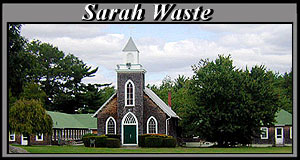 Birth: Sept. 4, 1748 in Freetown,
Bristol Co., Mass.
Death: May 16, 1789
Birth: Sept. 4, 1748 in Freetown,
Bristol Co., Mass.
Death: May 16, 1789
|
Sarah
Waste was the daughter of Charles Waste and Deborah Williamson.
She was born in Freetown, Bristol County, Massachusetts on Sept.
4, 1748. Sarah's brothers included Bezaleel and Eli Waste. She
married Peter Crapo (pronounced Cray' po) on Nov. 13, 1766 in
Dartmouth, Bristol, Mass. They had many children together. It's
notable that Sarah's sister Mercy married Peter's brother Consider
Crapo. Many remarkable details about Sarah and Peter's family
are below on this page. Sarah Crapo died on May 16, 1789, age
42.
"The
Historical Tour of Rochester, Massachusetts", by Judy Gurney
includes this:
". . . Left up Snipatuit Road,
through what we call the Crapo neighborhood, for it was first
settled by Peter Crapo. Peter was a ten-year-old boy when his
brother's ship wrecked off Cape Cod. Peter was French, spoke
no English, and couldn't even tell the settlers his name, so
they translated Pierre the Frenchman into Peter the Frog, and
frog was supposed to be Crapeaux, or a word something like that,
in early slang. So Peter Crapo he became, and all Crapos today
are his descendents.....This land was not part of the purchase
from Plymouth that became Rochester Center. This was purchased
from Chief Tispaquin by three men, one a Lothrop, and two Thompsons.
Thus it was the Lothrop and Thompson purchase, later designated
North Rochester and sometimes Snipatuit Quarter or Pond Village
. . ."
Take the
Historical Tour of Rochester, Massachsetts including "the
Crapo neighborhood"
Peter Crapo
Birth: Dec. 4, 1743 in Rochester,
Plymouth, Massachusetts
Death: March 10, 1822 in Freetown, Bristol, Massachusetts
Peter's father was John Crapo, born
Feb. 22, 1711 or 1712 in Rochester, Plymouth, Mass. His mother
was Sarah Clark, born May 18, 1714 or 1715 in Rochester, Plymouth,
Mass.
Peter married Sarah Waste on Nov.
13, 1766 in Dartmouth, Bristol, Mass. Following Sarah's death
on May 16, 1789, Peter married Content Peckham on Oct. 13, 1789
in Dartmouth. Content was born in 1754 in Freetown, Bristol,
Mass. |
After Sarah's death Peter married
Content Peckham and had five more children with her.
"Peter died at seventy nine
and was buried "in an old private burial ground, where many
of his descendants lie buried, in North Dartmouth, not far from
Braley's Station, and near the dwelling house formerly of Malachi
White." Sarah's gravestone "of grey slate with carved
cherubims and a scriptural verse stands on the right side of
Peter's stone." She died in the forty-second year of her
age. On his left is the stone of his second wife Content, who
died in the 68th year of her age."
Their grandson Henry Howland Crapo
was Governor of Michigan from 1865 to 1868. See a biography of
Henry Howland
Crapo.
Here
is another biography of Henry H. Crapo.
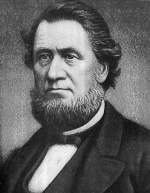 Michigan Governor Henry Howland
Crapo
Michigan Governor Henry Howland
Crapo
William Wallace Crapo was Governor
Crapo's son and Sarah and Peter's great-grandson. He was a member
of Congress.....here is
his biography.
Here
is a page with biographical
sketches of both Henry and William Crapo.
Biography
of William W. Crapo
Current United States Senator
Mike Crapo, R-Idaho is also descended from Peter Crapo. |
Peter and Sarah's
children
|
Richard Crapo, born about 1767 in Freetown,
Bristol, Massachusetts |
|
Azuba Crapo, born June 8, 1768 in Dartmouth,
Bristol, Massachusetts |
|
Peter Crapo, born about 1771 in Dartmouth,
Bristol, Massachusetts |
|
Elizabeth Crapo, born 1773 in Freetown,
Bristol, Massachusetts |
|
Sarah Crapo, born about 1775 in Freetown,
Bristol, Massachusetts |
|
Reuben Crapo, born Aug. 5, 1777 in Dartmouth,
Bristol, Massachusetts |
|
Charles Crapo, born April 18, 1780 in
Dartmouth, Bristol, Massachusetts |
|
Jesse Crapo, born May 22, 1781 in Freetown,
Bristol, Massachusetts. He married Phoebe Howland in 1803. Their
son Henry Howland Crapo was Governor of Michigan from 1865 to
1868. Jesse died on Jan. 11, 1831. |
|
Deborah Crapo, born April 4, 1786 in
Freetown, Bristol, Massachusetts |
Peter and Content's children
|
Content Crapo, born Oct. 12, 1790 in
Freetown, Bristol, Massachusetts |
|
Susanna Crapo, born July 23, 1793 in
Freetown, Bristol, Massachusetts. See an interesting story about
Susanna below. |
|
Abial Hathaway Crapo, born about 1795
in Freetown, Bristol, Massachusetts |
|
Orra Crapo, born about 1797 in Freetown,
Bristol, Massachusetts |
|
Joseph Crapo, born 1799 in Freetown,
Bristol, Massachusetts |
Freetown and Lakeville,
Massachusetts
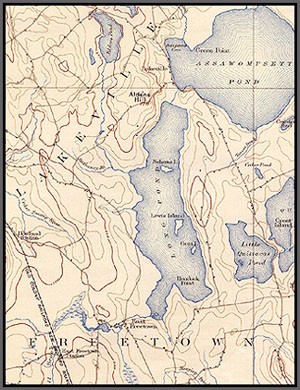 Click on map to see large
version.
Click on map to see large
version. |
Peter and Sarah's descendants
at the Crapo homestead, Sniapuit Road
Click to see more
Freetown, Massachusetts
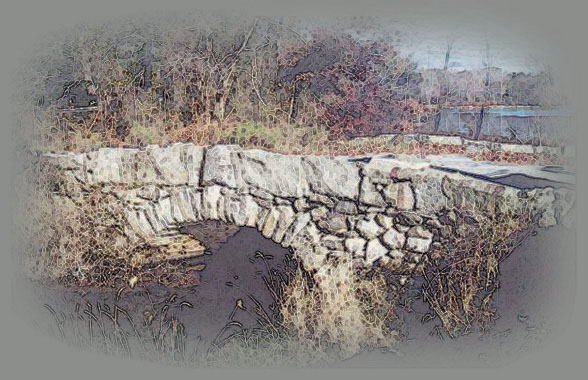 Gurney Bridge, Freetown was
built between 1820 and 1824
Gurney Bridge, Freetown was
built between 1820 and 1824
|
Peter Crapo's
family
"The children may have been
born in Freetown but appear in Dartmouth records. Birth of the
last one in the first marriage, Deborah, appears in Westport
records but may have been recorded there after her marriage and
while she and her husband lived there. All the sheets had Peter
as the oldest but it is more likely Richard as he is named first
in his father's will and his marriage date is earlier than that
of Peter. The 1770 birthdate would make him only 19 years of
age at time of marriage.
From "Certain Comeoverers"
by H. H. Crapo, 1912: "Peter Crapo, second of the name,
son of John, the son of Peter, ... seems to have been a stirring
sort of man of strong character, great energy and considerable
achievement. There are many stories of his forceful methods and
abounding vitality. When fifteen years of age it would appear
that he volunteered from Rochester in the French and Indian War.
At all events there was a Peter Crapo who was one of the company
that met at Elijah Clapp's in Middleboro on the morning of 29
May 1758 and at a little after sunrise commenced its' march to
and participated in the bloody and disastrous battle of Ticonderoga
in which their General, Lord Howe, was slain. It certainly seems
more probable that the Peter Crapo who went on this expedition
was this Peter, the son of John, born in 1743, rather than his
uncle, the only other Peter then existant, who was born in 1709
and would consequently have been almost fifty years of age. "With
such an experience in his boyhood it is not surprising that in
the alarm of 19 Apr 1775, (the battle of Lexington of which Paul
Revere gave warning on the evening of the eighteenth), Peter
Crapo as a private, and his brother Consider as a Sergeant, marched
under Captain Levi Rounseville from Freetown to the camp at Cambridge,
as is set forth in the muster rolls at the State House in Boston.
How long he served at this time I know not." "Mass.
Soldiers and Sailors" says he served 3 days. "It is
somewhat interesting that in response to this same alarm of 19
Apr 1775, the muster of the Rochester Company of minute men contains
these two names in sequence, 'William Crapo, corporal, Caleb
Coombs, private.'" (It will be remembered that this Peter's
grandfather, Pierre, was raised by a Francis Coombs. William
was probably the son of Pierre's oldest son, Francis. Other Crapos
listed in "Mass. Soldiers and Sailors" were Elnathan
and John, Jr., in 1777 and 1778. Another source says he was a
Lieutenant in July 1781. "In the records of Rochester's
quotas throughout the war the name Crapo appears many times.
"Peter again appears on the muster rolls as a private, his
brother Consider as a sergeant, and his brother Joshua as a corporal,
in Lieutenant Nathaniel Morton's company of militia from Freetown
belonging to the regiment commanded by Edward Pope, Esquire,
which marched out on the alarm of 8 Dec 1776, 'agreeable to the
orders of the Honorable Council thereon.' On this occasion Peter
was given twenty days' pay, to wit: 2 pounds, 10 shillings, 8
pence.
"It was, however, as an active
man of business that he has left his footsteps on the sands of
time. You will remember that the first Peter was something of
a lumberman since he bound himself to deliver 'one thousand good
merchantable rails at Acushnet landing,' and his grandson Peter's
greatest effort in life was as a lumberman, logging the cedar
and pine trees of Dartmouth and Freetown and sawing them at his
mill at Babbitt's Forge at the head of the Quampanoag River.
Afterwards his grandson, Henry H. Crapo, became a lumberman and
logged the pine forests of Michigan, sawing the lumber at Flint.
..... "At what date Peter, the second, moved from Rochester
to Freetown is not certain. I find a deed of land in Freetown
from Bigford Spooner in 1770 to Peter's brother Joshua. This
land was in the vicinity of the land which Peter later occupied.
Joshua did not remain in Freetown. He is said to have immigrated
to Maine. |
Woods near Freetown
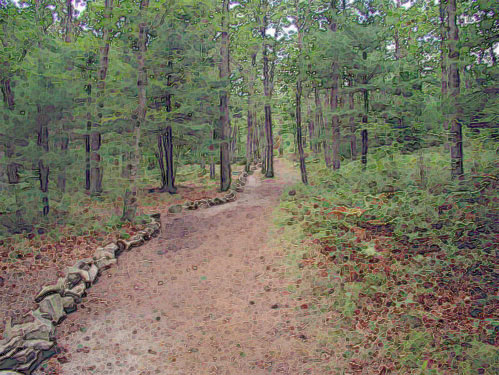
|
"Peter and his brother
Consider were settled in Freetown in 1773. They were engaged
in the lumber business. In 1774 and for nearly twenty years thereafter,
Peter and Consider were actively engaged in logging and sawing
as appears by the numerous recorded deeds to them. Their sawmill
was 'partly in Freetown and partly in Dartmouth' at a place called
'Quampog where a forge formerly stood called Babbitt's Forge.'
At one time an Abraham Ashley and a Mereba Hathaway, a widow,
were partners in their business. John Crapo, their father, conveyed
several tracts of land to them and seems to have been interested
with them in their business and may have lived with them for
a time. He is always described, however, as 'of Rochester'."
From "Old Dartmouth Sketches" section on "Mills
of New Bedford and Vicinity before the introduction of steam"
by H. B. Worth: "About 2 miles west of Brayley's station
on the line between Freetown and Dartmouth is a region called
Quanapog. At this point the Noquochocke River crossed the line
and in 1774 a large tract was laid out to Nathaniel Babbitt and
he established a forge on the town line. Babbitt's forge passed
into the hands of the Crapos. Then Peter Crapo and his associates
built two other mills a short distance south of the forge. The
Quonapog mills at one time were largely controlled by Malachi
White and later by the Collins family and in modern times was
owned by Gilbert N. Collins. The iron industry was changed to
a sawmill soon after the Crapos became owners."
|
Freetown
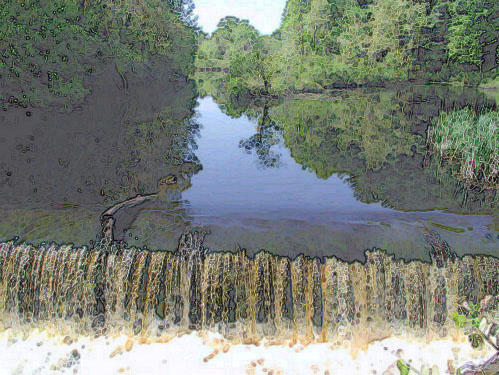
|
Continuing from "Certain
Comeoverers": "Some time after 1790 Consider withdrew
from the business and moved to Savoy, Mass. The deeds of partition
between the brothers are dated in 1797. Both brothers were owners
of considerable tracts in Dartmouth, owning salt meadows on Sconticut
Neck, and lots in Belleville in New Bedford and in Troy, now
Fall River. In 1793 Consider sold his homestead farm to Thomas
Cottle of Tisbury, Dukes County, who removed thither. This was
in the immediate vicinity of the sawmill since he reserved to
his brother Peter a right of flowage above his sawmill. Afterwards,
Peter Crapo appears to have taken in Richard Collins as a partner
in the business. In 1793 the sawmill burned down but it appears
to have been rebuilt. Down to the time of his death in 1822,
Peter Crapo, as abundantly appears by the land and court records,
was actively engaged in business.
Children of Peter Crapo
and Sarah Waste
"Peter had a large family of children, fourteen in all,
and it would seem that his manner of caring for them was distinctly
patriarchal. As each child came of age and was about to be married,
he summoned all the other children, the married and the unmarried,
to undertake some special work whose profit might be devoted
to settling the child to be married. In the case of a daughter
with a dowry, in the case of a son with a homestead farm. .......
"Peter kept the title of the various farms acquired for
his sons in his own name and, when he died, left them severally
by his will, dated 20 Feb 1822, to their occupants, devising
his own homestead farm which, as appears by the inventory of
his estate, was much the most valuable, to his youngest son Abiel,
the baby of the family, on whom he placed the duty of caring
for his widow. To his widow he also gave fifty dollars, one cow,
and "the use and improvement of the south front room in
my dwelling house with a privilege to pass and repass through
the kitchen and porch and to the well to draw water, as well
as a privilege in the cellar and the use and improvement of all
the household furniture during her life." She was his second
wife. "Considering her somewhat limited domain all the furniture
may have been too liberal, but it is to be hoped that Abiel really
did do his duty and made his mother comfortable. He gives to
his 'seven daughters' three hundred and fifty dollars each and
all his household furniture after his widow's death. His estate
was inventoried at something over $10,000, which was in those
days a considerable estate." The will actually says "unto
my seven daughters ... the sum of three hundred and fifty dollars
being fifty to each of them".
Peter died at seventy-nine and was
buried "in an old private burial ground, where many of his
descendants lie buried, in North Dartmouth, not far from Braley's
Station, and near the dwelling house formerly of Malachi White."
Sarah's gravestone "of grey slate with carved cherubims
and a scriptural verse stands on the right side of Peter's stone."
She died in the forty-second year of her age. On his left is
the stone of his second wife Content, who died in the 68th year
of her age. All three stones were well preserved at the time
of writing of "Certain Comeoverers", 1912. |
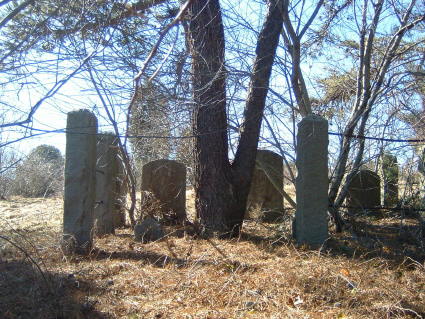 |
|
Crapo Cemetery in Freetown,
Massachussets |
|
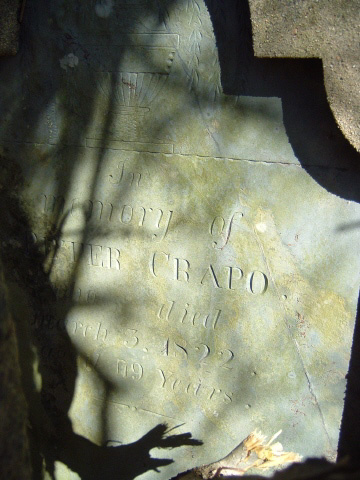 |
|
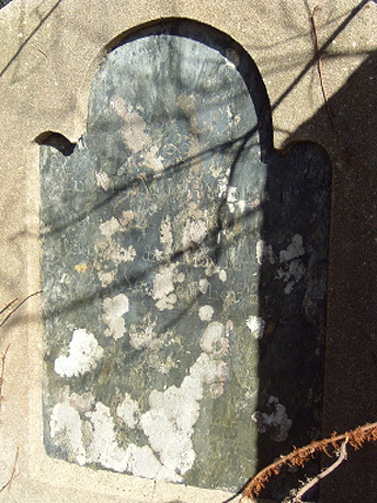
|
|
Tombstone of Peter Crapo |
|
Tombstone of Sarah
Waste Crapo |
'
Long Pond
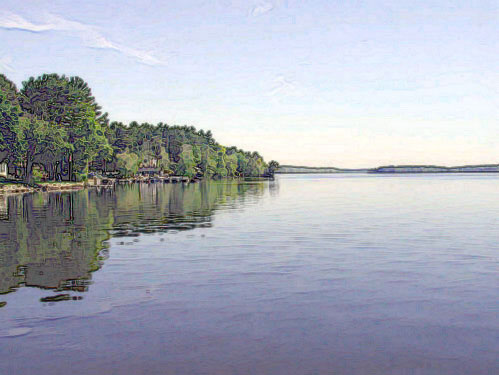
|
"Susanna Howland,
the remarkable old lady in the woods"
"In 1886 an enterprising reporter of the Boston Globe found
an interesting subject for a character sketch. Near Jucketram
Furnace in East Freetown, on the shore of Long Pond, he found
an old lady ninety-four years old on 25 Sept. 1886, named Susanna
Howland. According to the reporter she was a most remarkable
old lady, being a tireless worker at all manner of farm labor
in the fields and woods, and in the farm kitchen, hoeing, digging,
chopping, berrying in the swamp, planting the garden and harvesting.
In her later years she had, as a pastime, woven three thousand
yards of homespun cloth. The neighbors told queer stories about
finding this ninety-four year old woman in the woods chopping
with an axe, clad in men's attire, trousers, vest and blouse,
with stout top boots, working away for dear life with all the
grit and abandon of a backwoodsman."
"This remarkable woman turned out to be the daughter of
Peter Crapo. And she bore the name of her great great great great
grandmother Susanna White who came over in the Mayflower. The
reporter describes her as saying: 'My father's name was Peter
Crapo. He owned a great deal of property. The Indians used to
say 'Old Peter Crapo's jacket hung in the woods was worth more
than all the eel-spearing in Long Pond at sunrise.' When I was
a girl on my father's farm I remember how he would go out with
the neighbors and search in the old fields for the corn the Indians
were always stealing from the settlers. The Redskins would plant
it just below the surface of the ground in big pits that would
hold bushels and bushels and then they would turn the ground
up all around so that no one could tell where the pits were.
The white men would go out with their horses and ploughs and
plough these fields until the corn pits were found, and sometimes
the Indians would be prowling round in the woods and when they
saw the corn was found, sometimes there would be a skirmish and
somebody got killed.' Susanna Howland seems to have inherited
all the energy and grit of her father."
|
|
|